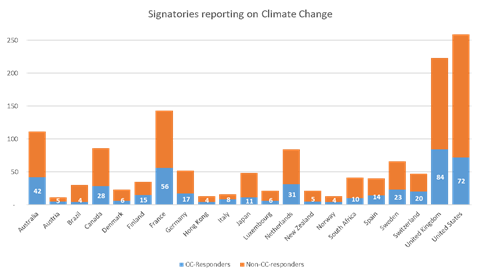With the issue a hot topic in the financial sector, the PRI incorporated pilot climate reporting indicators into its 2018 Reporting Framework, based on the June 2017 TCFD recommendations.
The aim was to improve industry disclosure and enable investors to implement TCFD guidance. The TCFD recommendations were centered around four thematic areas that represent core elements of how organisations operate: governance, strategy, risk management, and metrics and targets.
Key findings of the PRI’s climate reporting
High number of respondents to the (voluntary) indicators.
In total, 480 PRI signatories completed the indicators in the 2018 Reporting Framework. The chart below shows by country the number of PRI signatories that opted in and those that did not.

Over 100 public disclosures.
Nearly a third (133) of the 480 PRI signatories that completed the pilot climate reporting indicators made their data publicly available. Those organisations that have made their results public are those that are likely to have the best developed and most advanced systems and processes. As such, the results signal where the investment community as a whole is heading on this issue, and highlight where the greatest current needs and gaps in practice lie.
Geographic distribution of disclosures heavily weighted towards Europe.
Ninety-eight of the 133 respondents came from this region. The others were from North America (23); Oceania (9); Africa (2); and Latin America (1). The results are probably best seen as capturing current practices in Europe and, to an extent, North America.
As the questions were voluntary, not all respondents completed all the indicators. Therefore, in places, we express the results in percentages as well as in terms of the actual numbers of signatories taking specific actions.
Findings by TCFD recommendation area (based on public disclosure)
Governance
- Almost all public climate change respondents have assigned oversight and/or implementation responsibilities for climate-related issues. In fact, only one of the 133 organisations did not have at least one individual with oversight/accountability for climate-related issues or with responsibility for the assessment and management of climate-related issues.
- Oversight responsibilities and accountabilities for climate change usually sit at the most senior levels of the organisation. For example, 95% of boards or trustees (89 out of 94) and 96% of the most senior individuals (depending on the organisation, this could be Chief Executive Officer (CEO), Chief Investment Officer (CIO), Chief Risk Officer (CRO) or Investment Committee) have responsibility for the oversight of the organisations’ efforts on climate change. These individuals are often supported by a specialist responsible investment professional or an individual that oversees for responsible investment. Of the 93 respondents that had such a role within their organisation, 73 (or 78%) indicated that this individual also had responsibility for oversight of their climate change-related activities.
- Responsibilities for implementation tend to be distributed through the organisation, with the specific allocation of responsibility depending on the nature and scale of the organisation.
Explicit responsibility for the assessment and management of climate-related issues among public climate change respondents:
- 95% of boards (89 out of 94)
- 53% of senior management (e.g. CEO, CIO, CRO, Investment Committee) (49 out of 92)
- 86% of portfolio managers (79 out of 92)
- 100% of responsible investment specialists (93 out of 93)
Strategy
- Most organisations that reported publicly to the climate change indicators have identified the main climate-related risks and opportunities they face over the short, medium and long term. In total, 123 of the 133 respondents (92%) listed the main risks and opportunities associated with climate change, and describe how these might affect their businesses, strategy and financial planning.
- Many of those organisations that reported publicly now explicitly reference climate change in their investment policies. Of the 133 respondents, 95 (71%) had included climate change in their investment policies. Of these, 86 had also included climate change in their investment strategies.
- Only a small proportion of respondents have conducted or used some form of climate scenario analysis. Forty-two of the 133 public respondents (32%) had considered scenario analysis that includes factors representing the investment impacts of future climate-related risks and opportunities. Thirty-four of these analyses had explicitly considered a 2°C or lower scenario.
Risk management
- Around two-thirds of public climate change respondents integrate climate change into their risk management processes. Of the organisations that answered this question, 85 out of 120 (71%) integrated climate change into their risk management processes, but 35 (29%) do not.
- Most organisations engage with investee companies to encourage better disclosure and practices around climate-related risks. Of the 126 respondents to this question, 106 (83%) indicated that they use engagement as a risk management strategy and 20 (17%) do not.
Metrics and targets
- There is limited consistency in the metrics being used to assess and track performance by those that responded to the climate change indicators. In most cases, the metrics are based on Scope 1 and 2 greenhouse gas emissions.
- As yet, few investors have set climate-related targets for their portfolios. Only 34 of the 133 respondents (25%) indicated that they have set targets. Of these, 10 applied to the whole portfolio and a further six to a majority of their portfolio. The remainder (18 out of 34) either applied the target to a minority of their assets, to a specific fund or did not specify the scope of the target.
Implications for policy makers and global investors
The results of the PRI’s first year of pilot climate reporting based on TCFD are encouraging. It suggests that many investors are actively looking to implement the TCFD recommendations. It also indicates that there is a body of expertise and knowledge that we can draw on as we work with our members to encourage a wider adoption of the TCFD recommendations.
Unsurprisingly, the results suggest that disclosure on the governance of climate change and the management of the risks and opportunities of climate change is more developed than other areas. The PRI’s discussions with signatories suggest that the maturity of their organisational approach to responsible investment allows them, relatively easily, to extend the scope of their efforts on implementation and reporting to cover additional issues.
One of the interesting insights from a deeper look at the climate data is that timeframes continue to have a profound effect on the issues that investors consider relevant to them. For example, almost half of the public respondents indicated that they define medium-term as somewhere between two and five years, and almost 40% defined long term in the same way. This suggests that further industry work is needed on timeframes and material climate risk.
The results also suggest that more work is needed on scenario analysis and on targets and metrics. These are related as the process of setting targets and defining metrics needs to be informed by views on what the future might look like, and what we want the future to look like. The wide variation in the performance metrics used by investors reflects the fact that integration of climate change into investment research and decision making is still evolving at an industry level.
The PRI’s next steps:
The 2019 PRI Reporting Framework will continue to include pilot climate reporting indicators based on the TCFD. The indicators will be updated to incorporate signatory feedback including the need for streamlining and more practical guidance. The PRI will continue to drive TCFD implementation across markets, encouraging regulators, companies and investors to advance further.
- Regulators: the PRI has shared key findings with the Task Force to inform its 2018 report to the FSB. The PRI will continue to encourage regulators to endorse the TCFD as per the recommendations of our PRI-Baker McKenzie country reviews.
- Investors: advancing investor use of climate scenario analysis recommendations will be a priority area for the PRI, with a new online free tool available. The PRI will also facilitate investor sharing of good practice and lessons learned to advance TCFD-based investor disclosure.
- Companies: the PRI will encourage investors to engage companies to adopt the TCFD recommendations through ClimateAction100+.
The PRI welcomes feedback and questions on these findings to [email protected].
About the Task Force on Climate-related Financial Disclosures
In 2015, the Financial Stability Board established an industry-led task force - the Task Force on Climate-related Financial Disclosures (TCFD). The Task Force’s aim was to help identify the information needed by investors, lenders, and insurance underwriters to appropriately assess and price climate-related risks and opportunities. The PRI’s Chair, Martin Skancke, served on the TCFD and PRI signatories actively provided input to the TCFD’s recommendations.







